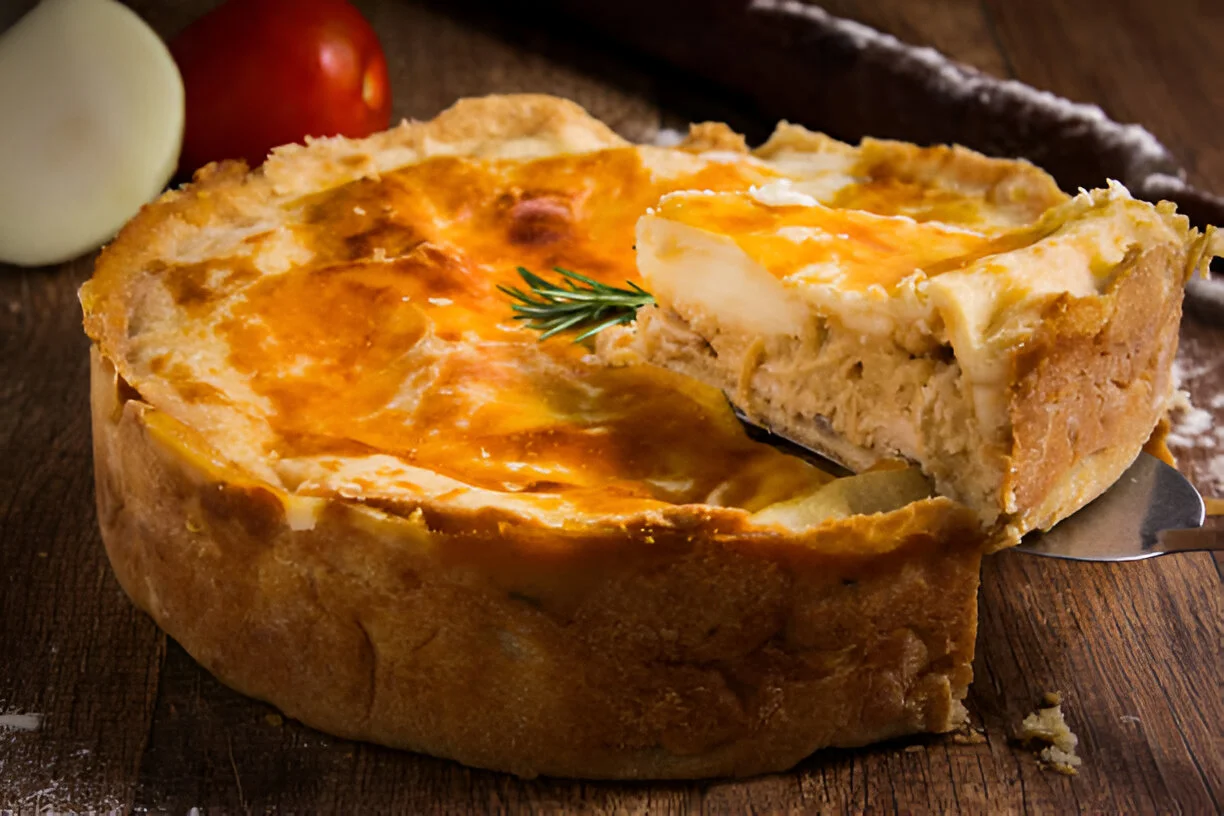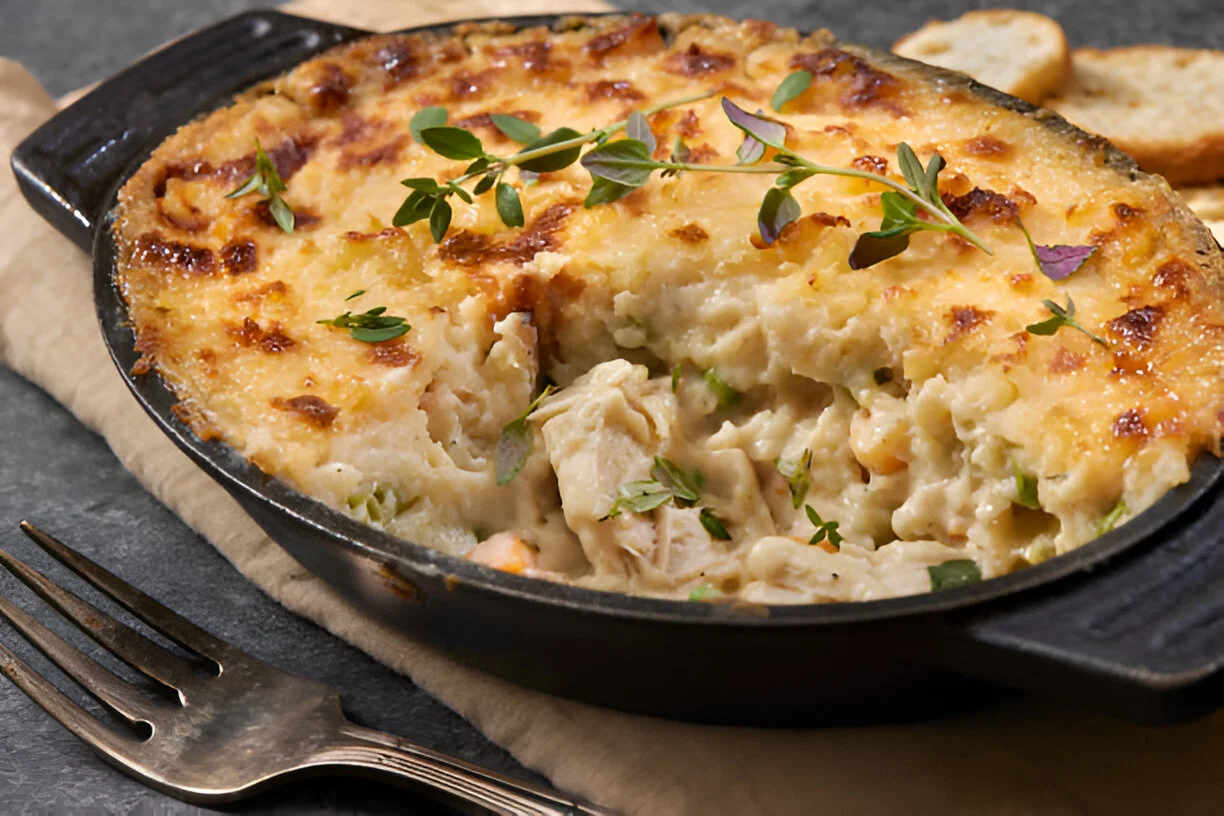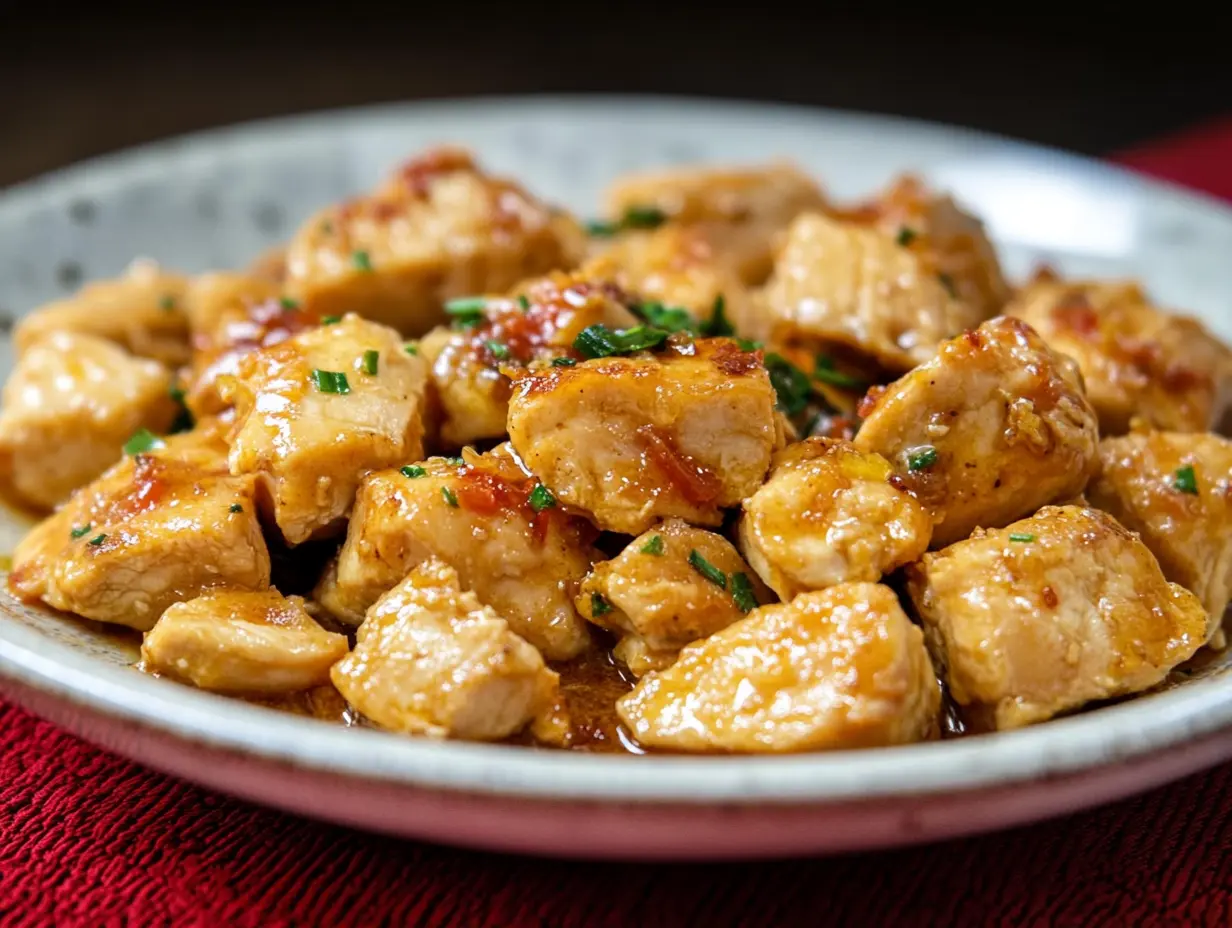Chicken pot pie is a beloved comfort food that’s rich, hearty, and satisfying. But if you’re watching your calorie intake, understanding how many calories are in chicken pot pie is essential. Whether it’s homemade, store-bought, or from a fast-food chain, the calorie count can vary significantly. Let’s break down the nutritional details of chicken pot pie, explore the factors that impact its calories, and discuss healthier alternatives.
Calorie Overview
Chicken pot pie, a classic comfort food, is known for its rich, hearty flavors and satisfying qualities. However, it’s important to be aware that this beloved dish can be quite high in calories, which may be a concern for those mindful of their calorie intake. The calorie content of chicken pot pie varies significantly depending on its preparation method and ingredients.
On average, a typical serving of chicken pot pie ranges between 300 to 600 calories. Several factors contribute to this wide calorie range:
- Crust: The crust is a major contributor to the calorie count. Often made with butter or lard, it is rich in fats. This buttery, flaky crust can add a substantial amount of calories to each serving.
- Creamy Filling: The filling is another calorie-dense component. Many recipes use heavy cream or milk to achieve that creamy texture, which adds extra calories from fats and sugars.
- Chicken and Vegetables: Although chicken and vegetables are generally healthy, the calorie count can still add up. The type and amount of chicken, along with the inclusion of starchy vegetables like potatoes or peas, can significantly impact the total calorie count.
For more detailed nutritional facts, Nutritionix provides an extensive breakdown of chicken pot pie calories, including the fats, carbs, and protein in each serving.
Calories in Homemade Chicken Pot Pie
When it comes to homemade chicken pot pie, the calorie count can vary based on your recipe and ingredients. Generally, a slice of homemade chicken pot pie contains between 400 to 500 calories. Here’s a closer look at the calorie breakdown for a typical homemade pie:
- Crust: The crust of a homemade chicken pot pie usually contains around 150 to 200 calories per slice. This can vary depending on whether you use a traditional butter-based crust or opt for a lighter, whole wheat version.
- Chicken: The chicken component contributes approximately 100 to 150 calories per serving. The calorie count here can differ based on the type of chicken used, such as lean breast meat versus more fatty cuts.
- Vegetables and Filling: The creamy filling, which often includes vegetables like carrots, peas, and potatoes, can add another 100 to 150 calories. The use of cream or cheese in the filling further increases the calorie count.
You can lower these calories by using whole wheat crust, lean chicken, and more vegetables. If you’re looking for specific ways to make healthier chicken pot pies, check out this helpful guide with tips on ingredient substitutions (Summer Yule Nutrition and Recipes).
Store-Bought Chicken Pot Pie Calories
Store-bought chicken pot pies offer convenience but often come with a higher calorie count due to their ingredients and preservatives. Here’s a breakdown of calories in popular store-bought chicken pot pies:
- Marie Callender’s Chicken Pot Pie: A serving of Marie Callender’s chicken pot pie contains approximately 600 calories. This high calorie count is largely due to the rich, buttery crust and the creamy filling, which are packed with fat and sodium.
- Costco Chicken Pot Pie: Roughly 400-500 calories per slice, with a rich, creamy filling (Summer Yule Nutrition and Recipes).
Store-bought chicken pot pies are convenient for busy lifestyles, but they often come with higher amounts of sodium and preservatives. If you’re concerned about these factors, it might be worthwhile to consider healthier homemade alternatives or look for store-bought options that advertise lower sodium and fat content.
Fast-Food Chicken Pot Pie Calories
Fast-food chicken pot pies are a popular choice for those seeking a quick and convenient meal. However, these fast-food versions are often high in calories, fat, and sodium, which can be a concern if you’re trying to manage your calorie intake. Let’s explore the calorie content of some well-known fast-food chicken pot pies:
- KFC Chicken Pot Pie: KFC’s chicken pot pie is known for its hearty and satisfying taste but comes with a hefty calorie count. Each serving contains approximately 720 calories, making it one of the more calorie-dense options available. The high calorie content is primarily due to the rich, buttery crust and the creamy filling, which are loaded with fat and sodium.
- Other Fast-Food Chains: While KFC is a prominent example, other fast-food chains also offer chicken pot pies with similarly high calorie counts. For instance, pot pies from chains like Popeyes or Chick-fil-A may contain comparable amounts of calories, often ranging between 500 to 800 calories per serving. These variations are influenced by the preparation methods and ingredient choices used by each chain.
Fast-food chicken pot pies can be a tempting choice for their flavor and convenience, but they should be consumed in moderation if you’re keeping an eye on your calorie intake. Opting for lighter options or balancing your meal with healthier sides can help manage your overall calorie consumption.
Nutrition Breakdown: Macronutrients and Micronutrients
Understanding the nutritional breakdown of chicken pot pie helps in making informed dietary choices. Let’s delve into the macronutrients and micronutrients present in this comforting dish:
- Macronutrients:
- Fats: Chicken pot pie is rich in fats, especially due to its buttery crust and creamy filling. Fats are a significant source of calories in this dish, with a typical serving containing a substantial amount of saturated and sometimes trans fats. These fats contribute to the overall calorie count and can impact heart health if consumed in excess.
- Carbohydrates: Carbohydrates are provided by the crust and any starchy vegetables included in the filling, such as potatoes or peas. The carbs in chicken pot pie come primarily from refined flour in the crust and the starches in the vegetables, contributing to the dish’s calorie density.
- Protein: Chicken pot pie contains a decent amount of protein from the chicken. This macronutrient is essential for muscle repair and growth, but in chicken pot pie, the protein content may be overshadowed by the high levels of fats and carbohydrates.
- Micronutrients:
- Vitamins and Minerals: Chicken pot pie can provide some essential vitamins and minerals, such as vitamin A from vegetables like carrots and iron from chicken. These micronutrients contribute to overall health, but the nutrient density might be compromised by the high calorie and fat content of the dish.
- Additives: Store-bought and fast-food versions may include preservatives and higher sodium levels. Excess sodium can be a concern for those managing blood pressure or heart health, making it important to check nutrition labels and ingredient lists.
Health Considerations and Dietary Restrictions
Chicken pot pie, while delicious and comforting, may not be the best choice for everyone, particularly those with specific health concerns or dietary restrictions. Here’s a closer look at some key considerations:
- Caloric Content: Due to its high calorie and fat content, chicken pot pie may not be suitable for those following a calorie-restricted or low-fat diet. Consuming large portions or frequent servings can lead to excessive calorie intake and potential weight gain.
- Heart Health: The high levels of saturated fats and sodium in chicken pot pie, particularly in store-bought or fast-food versions, can impact heart health. For individuals managing cholesterol levels or hypertension, it’s important to limit intake or choose lower-fat and lower-sodium alternatives.
- Gluten and Allergies: Traditional chicken pot pie recipes use wheat flour in the crust, which contains gluten. For those with celiac disease or gluten sensitivity, gluten-free crust options are available. Additionally, individuals with food allergies should be cautious of ingredients like dairy and eggs.
- Vegetarian and Vegan Diets: Chicken pot pie is typically not suitable for vegetarians or vegans due to the use of chicken and dairy products. However, there are vegetarian and vegan adaptations available that use plant-based proteins and non-dairy alternatives.
How to Make Healthier Chicken Pot Pie
Making a healthier version of chicken pot pie is achievable with some simple ingredient substitutions and cooking methods. Here are some tips to help you create a lighter, yet still delicious, chicken pot pie:
- Ingredient Substitutions:
- Crust: Replace traditional crust with a whole wheat or low-fat crust. Whole wheat options offer more fiber and nutrients, while low-fat versions reduce calorie content.
- Filling: Use low-fat milk or chicken broth instead of heavy cream to reduce calorie and fat content. Adding extra vegetables can also increase the dish’s nutritional value without significantly affecting the calorie count.
- Chicken: Opt for lean chicken breast instead of darker, fattier cuts. Lean chicken breast is lower in fat and calories, making it a healthier choice for your pot pie.
- Cooking Methods:
- Air Frying: Using an air fryer can help achieve a crispy crust with less oil compared to traditional frying methods, leading to a lower-calorie dish.
- Baking: Baking your pot pie allows for better control over the crust’s texture and can reduce the need for additional fats compared to frying.
- Portion Control: Serving smaller portions or making mini pot pies can help with calorie management. This approach allows you to enjoy the dish without overindulging.
Frequently Asked Questions (FAQs)
Is Chicken Pot Pie High in Calories?
Yes, chicken pot pie is generally high in calories due to its rich, buttery crust and creamy filling. A typical serving can range from 300 to 600 calories, depending on the recipe and portion size. For those keeping track of calorie intake, it’s important to be mindful of serving sizes and ingredient choices.
How Can I Lower the Calorie Count in Chicken Pot Pie?
To reduce the calorie content of chicken pot pie, consider using whole wheat crusts, low-fat milk or broth instead of heavy cream, and increasing the amount of vegetables while reducing the amount of chicken. These adjustments can help you enjoy a lighter version of the dish without sacrificing flavor.
Are Frozen Chicken Pot Pies Unhealthy?
Frozen chicken pot pies can be higher in sodium and fat due to preservatives and added ingredients. Opting for homemade versions or choosing low-sodium frozen varieties can be a healthier alternative. Always check nutrition labels to make informed choices.
What Is the Best Way to Reheat Chicken Pot Pie Without Adding Extra Calories?
The best way to reheat chicken pot pie without adding extra calories is to use an oven or air fryer. These methods help maintain the texture of the crust and do not require additional oil, unlike microwaving, which can make the crust soggy.
Conclusion
Chicken pot pie is a comforting and delicious dish that many people enjoy, but its high calorie content can be a concern for those watching their diet. By understanding the calorie content of different versions—whether homemade, store-bought, or from a fast-food chain—you can make more informed choices about incorporating this dish into your meal plan.
Making healthier versions of chicken pot pie involves choosing better ingredients and employing cooking methods that reduce fat and calorie content. With the right substitutions and portion control, you can still enjoy the comforting flavors of chicken pot pie while managing your overall calorie intake. This guide provides a comprehensive understanding of chicken pot pie’s nutritional aspects and offers practical tips for enjoying this classic dish in a healthier way.












Leave a Reply